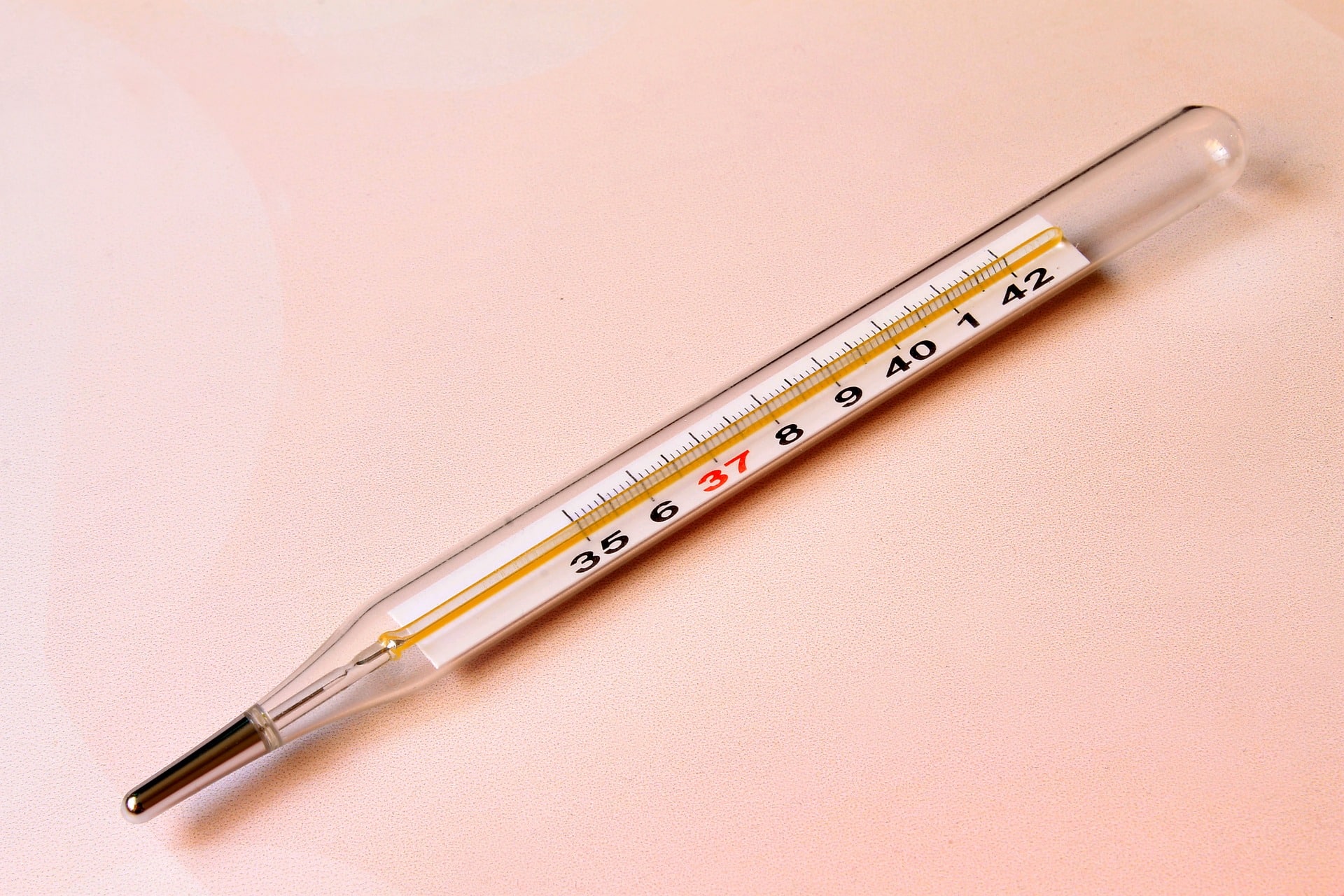Fever in dogs
Just like humans, dogs can get a fever. It is a natural reaction of the body that can occur in many situations.
However, "normal" does not mean "harmless", and an outbreak of fever in a dog can reveal a serious health condition and lead to severe after-effects. In fact, this phenomenon should never be overlooked. Since it can be difficult to determine whether a dog has a fever or not, here's everything you need to know about this mechanism, its symptoms, causes and consequences.
What is fever in dogs?
Fever is a defense mechanism that manifests itself as an increase in body temperature, also called hyperthermia. Dogs have a slightly higher normal body temperature than humans, which can lead to the misconception that they have a fever. A healthy dog has a body temperature between 38°C and 39°C.
The hypothalamus, a part of the brain, controls the peripheral neurons that cause heat loss (hypothermia) and heat production (fever). Fever occurs when substances, called pyrogens, interfere with the function of the hypothalamus and impact temperature regulation.
Pyrogens can be of two types: endogenous, when their production is triggered by cells in the body, and exogenous, when they are produced by infecting microorganisms. All cells in the body can produce pyrogens when under stress, but it is mainly leukocytes (white blood cells) that are responsible for febrile states.
By raising the body temperature, the body stimulates its immune system and initiates microbiota, a phenomenon that reduces the amount of iron available to pathogens. Fever evolves in 3 stages: temperature rise, plateau, and drop to a normal level.
While this might suggest that fever is a good thing for a sick dog and that it should be left in that state so that the body can naturally fight off pathogens, the truth is a bit more nuanced. In mammals, fever is a remnant of an immune defense mechanism, inherited from distant, probably aquatic, ancestors.
Indeed, in fish and cold-blooded animals, fever is a much more effective response to pathogens, as their temperature rises significantly during this process, without this being dangerous for their health. In dogs, and other mammals, the increase in temperature is very limited, and the role of fever in the body's defense is equally limited.
On the other hand, a high fever, which occurs when the body loses control of its immune response to an overly virulent pathogen, can cause lasting nerve damage.
Symptoms of fever in dogs
Fever in dogs is often asymptomatic, and is usually only noticed when a rectal thermometer is used to measure a temperature above 39°C (other types of devices are not considered reliable in dogs). Nevertheless, the animal sometimes appears tired, tired, aching, and may tend to hide in a quiet corner and growl when you try to approach him.
Discrete shivers may be observed, as well as a decrease or loss of appetite and bright red mucous membranes. Finally, it is possible to feel a more intense heat than usual when stroking your dog, especially on the head and ears. However, a hot nose is not a sign of fever, contrary to a persistent legend.
In most cases, fever is associated with other symptoms caused by the same pathogen or phenomenon that causes it. A wide variety of symptoms can therefore accompany the rise in the dog's body temperature, whether they are nervous (tremors, paralysis, etc.), respiratory (shortness of breath, coughing, etc.), cardiac (coughing, fatigue, etc.), general (fatigue, pain, stress, etc.), articular, ocular, cutaneous...
Unlike heat stroke, a fever does not cause panting and agitation, and does not exceed - or very rarely - 41.5°C in dogs.

Causes of fever in dogs
We tend to spontaneously associate fever with a bacterial or viral infection, but this phenomenon is not always caused by an infecting agent. While viruses and bacteria typically cause fever in dogs, certain cancers, parasites (piroplasmosis), trauma, autoimmune diseases or chronic inflammation can also be involved.
Toxins, due to the absorption of a poisoned substance or a snake bite, can also cause fever, in which case there are often associated nervous symptoms. There are also idiopathic fevers, the origin of which cannot be determined, and hereditary forms such as Shar Pei Family Fever.
Consequences of fever in dogs
Fever has no consequences on the dog's health when it is under control, i.e. when it does not reach excessive temperatures (more than 41°C) and does not last long (more than 48 hours). However, as mentioned above, fever does not effectively fight against the most virulent pathogens and non-infectious phenomena that cause it: it is the consequences of these underlying disorders that are to be feared.
Cancers, traumas and poisonings may eventually lead to the death of the animal if left untreated. Viral or bacterial diseases (Parvovirosis, Leptospirosis, etc.) can become complicated and cause your pet to suffer long-lasting after-effects or even death.
In addition, when the dog's body can no longer control its immune response and the fever is excessively high or prolonged, the dog may become dehydrated and suffer nerve damage, which is generally irreversible. This is particularly likely to occur when the pathogen involved is too virulent, or when the dog has an autoimmune, inflammatory or genetic disease associated with a loss of body temperature control.
It is also more likely to occur in older, sick or frail animals, as well as in young puppies, whose bodies are still barely able to regulate body temperature under the right conditions.
What should I do if my dog has a fever?
Before knowing what to do about a dog with a fever, it is important to take the dog's temperature to make sure it is feverish and to measure the severity of the problem. A rectal thermometer with a soft tip is the best accessory to do this. It's easy to find in supermarkets, pet stores or pharmacies, and a thermometer designed for human babies works just fine.
If your dog's temperature is over 39°C, he has a fever, and if it is over 41°C, it is an absolute veterinary emergency. If your dog's fever is moderate (less than 41°C), you can take the time to evaluate the situation before taking him to a veterinarian, based on two major criteria: his profile and his symptoms.
The dog's profile is based on his age, general health, breed, predisposition, lifestyle and medical history. If your dog is old, very young, fragile, sick, subject to chronic or hereditary pathologies, if it has been in contact with a sick fellow dog recently, if it participates in risky activities and/or is not vaccinated, you should consider it at risk and bring it to a veterinarian quickly.
At-risk activities include hunting, where the dog is in contact with wild animals that carry diseases (such as rabies), walking in the woods, where he is particularly exposed to ticks that carry serious diseases, or walking in areas where snakes are present. Gluttonous dogs, who eat anything, are also often victims of poisoning and intestinal obstructions that can cause fever.
Evaluating the dog's symptoms can also give you an idea of the severity of the condition that may be behind a fever attack. It may be surprising, but the absence of any other symptoms should alert you as much as the presence of severe symptoms.
A dog that suddenly develops a fever for no apparent reason is potentially fighting sepsis, inflammatory disease, cancer or some other asymptomatic condition, usually more serious than a common viral or bacterial infection. In contrast, moderate vomiting and diarrhea, for example, are more suggestive of transient gastroenteritis, a common condition that is usually not serious.
As a general rule, fever is a serious factor and should lead you to a veterinarian without delay or, at the very least, prompt you to call your veterinarian for further advice on what to do. If your dog is healthy and in the prime of life, his fever is not too high and he does not show any other severe symptoms, you can wait 24 hours before taking him to a veterinarian.
Note, however, that if his fever is a symptom of a severe disease or disorder, the longer you delay taking him to the vet, the worse his prognosis will be. Now that you know what to do if your pet has a fever, it's time to talk about what not to do.
Never give your dog fever medication without the explicit approval of your veterinarian, and even less so human medication. Paracetamol, the component of Doliprane or Efferalgan, is deadly for dogs, and Aspirin can also cause serious health problems.
Also, do not try to cool the animal, unless his fever is very high, over 41°C, and you do not have the possibility to take him to a veterinarian in emergency. Even if the fever is a defense mechanism whose effects are very limited in mammals, it remains the animal's best asset in the absence of veterinary treatment.
While waiting for your dog to be treated as soon as possible, it is important not to try to destroy the immune response of his body by lowering his body temperature or by giving him anti-inflammatory drugs. Finally, since a fever is not always related to an infection, do not give your dog antibiotics without your veterinarian's approval.
These drugs are only effective against certain bacteria and, if used incorrectly, lose their effectiveness by inducing bioresistance in the pathogens exposed to them, which then become difficult, if not impossible, to eliminate.

Treatment of fever in dogs
Once the dog is under the care of a veterinarian and the cause of the fever is diagnosed, medication can be used to lower the temperature. This type of treatment increases the animal's comfort and avoids inflammatory complications and nerve damage as the veterinary care takes over the dog's immune system, treating the disease more aggressively and effectively.
In a dog that is unwell and/or severely dehydrated, an IV drip can be started to stabilize the dog's condition and prevent hypovolemia. When the dog has no symptoms associated with his fever, a hospitalization is often necessary in order to carry out complementary exams and to find the appropriate treatment.
FAQ
How do I get my dog's fever down?
Although a fever is much less effective and more dangerous for your dog's health than a veterinary treatment, it is advisable not to reduce it while waiting to consult a veterinarian - as soon as possible! It allows your dog's body to defend itself against infections while waiting for medication prescribed by the veterinarian to take over. If you are unable to take your dog to the veterinarian and his fever exceeds 41°C, the threshold at which it becomes dangerous for his health, you can try to cool him down by wrapping him in a wet towel.
How do I know if my dog has a fever?
The only way to know for sure if a dog has a fever is to take his temperature with a soft-tip rectal thermometer. Other types of thermometers are not considered reliable in dogs, and fever does not have typical symptoms that would otherwise allow it to be diagnosed.
My dog has a hot nose, does he have a fever?
No, a hot and/or red nose in dogs is not a symptom of fever, contrary to a persistent legend. It is more likely that your dog has been burned, or that he is suffering from a local infection.
My dog has hot ears, does he have a fever?
It's hard to tell if a dog has a fever by touching his ears, but it's true that you can sometimes feel a more intense heat than usual in the head and earlobes of a dog with a fever. However, this is not a very reliable method, and it is best to take a dog's rectal temperature to check for fever.
What medications should I give my dog with a fever?
It is highly inadvisable to give any medication to a dog with a fever without the approval of a veterinarian. Most human medications are toxic to dogs (Doliprane, paracetamol, Aspirin, etc.), and anti-inflammatory drugs, whether for dogs or not, will decrease the immune response of the dog's body, leaving it defenseless against the pathogen that is causing the fever.
Fever is not always a symptom of a serious condition in dogs, but only a veterinarian can determine what is behind the temperature rise and implement, when possible, an appropriate treatment. It should be noted that fever is not a disease, but a reaction of the body to defend itself against infection or to respond to cellular stress.

